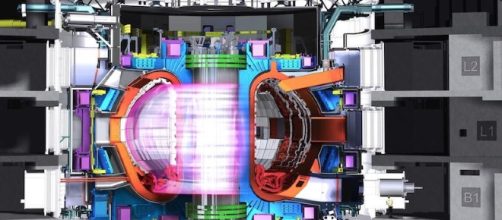Fraser Cain, writing for Universe Today, thinks that a working Fusion Reactor that can feed electricity into the grid is about 30 years away. That estimate includes ten years to get a reactor online that can generate more power than it feeds in and then another two decades of more development before commercial reactors are available. 30 years seems like a long time, but it is an improvement over the old adage that says that fusion power is 50 years away and has been so for the past 50 years.
How does fusion power work?
A controlled fusion reaction begins when a quantity of hydrogen is heated into a plasma and is contained by a magnetic field.
The hydrogen is fused into helium and released heat that can be used to turn a turbine. The problem is that so far researchers have not been able to extract more power out of a fusion reactor than is put in to sustain the fusion process. But, scientists are getting close. One other drawback is that the fusion reaction irradiates the reactor, causing a cleanup problem after a certain point. However, a fusion reactor would not melt down as a nuclear version would. Any trouble with the reactor would cause the fusion process to stop and the reactor to gradually cool.
Is fusion the solution to energy problems?
On its face, fusion power seems to be very attractive. Unlike natural gas or coal, it does not require fossil fuels.
Hydrogen can be extracted from water. Fusion does not emit any pollution. Unlike solar power, fusion runs 24 hours a day. Unlike wind turbines, it runs in all weather, whether a breeze exists or not. The amount of power that a switch to fusion will generate is only limited to the number and size of plants that get built.
The economics of the technology
Depending on the economics, fusion power may create a permanent, inexpensive energy economy, not quite too cheap to meter as was once the promise of nuclear energy, but enough so that the price is manageable, and, moreover, predictable. Energy run on fossil fuels has been subject to unpredictable price spikes and dips. Historically, price spikes have been caused by political turmoil in the Middle East.
More recently, the price of oil and natural gas have collapsed due to the fracking boom.
Without energy as a limiting factor, the world economy would have any potential to take off limited only by human imagination and government regulation. In short, 30 years cannot pass by quickly enough.


